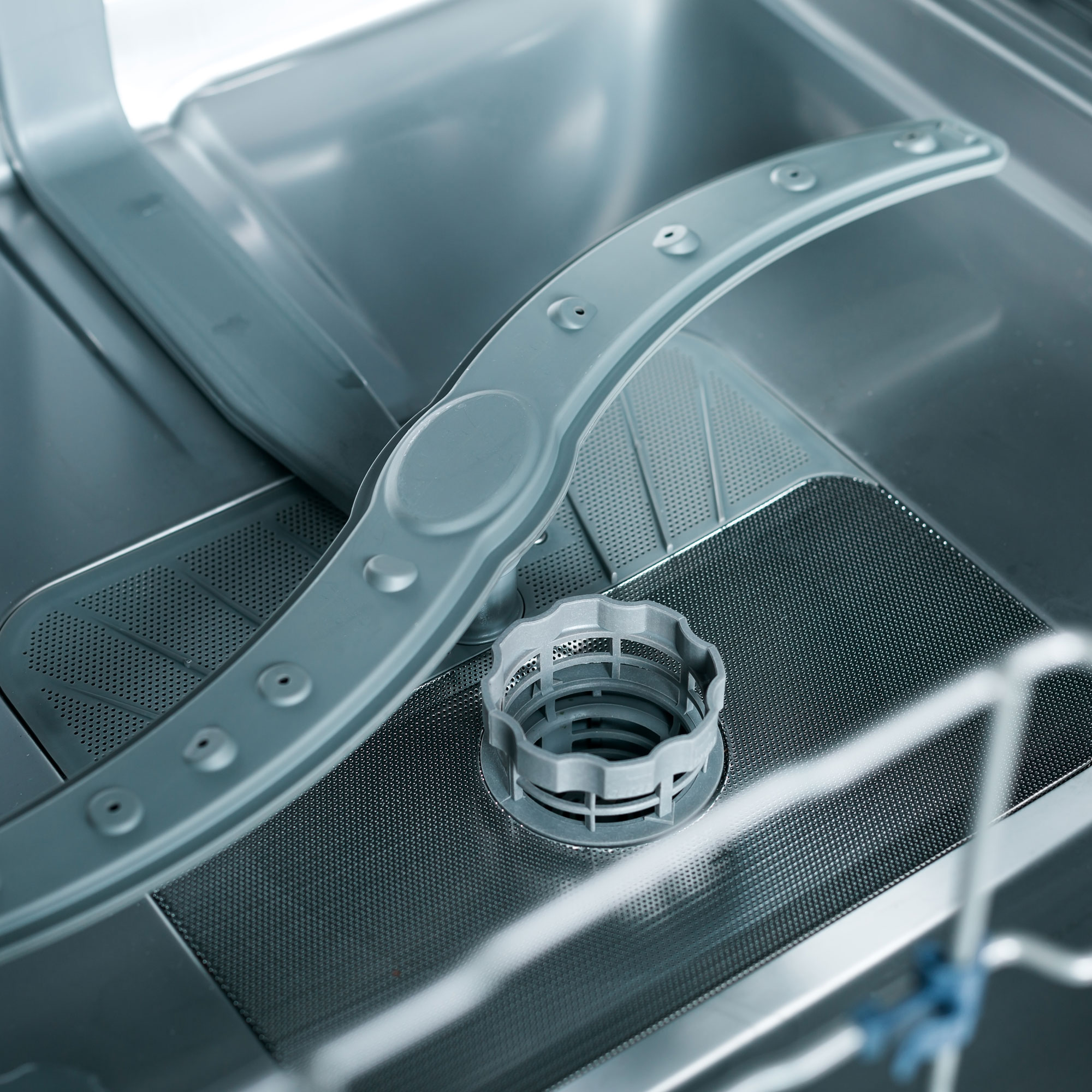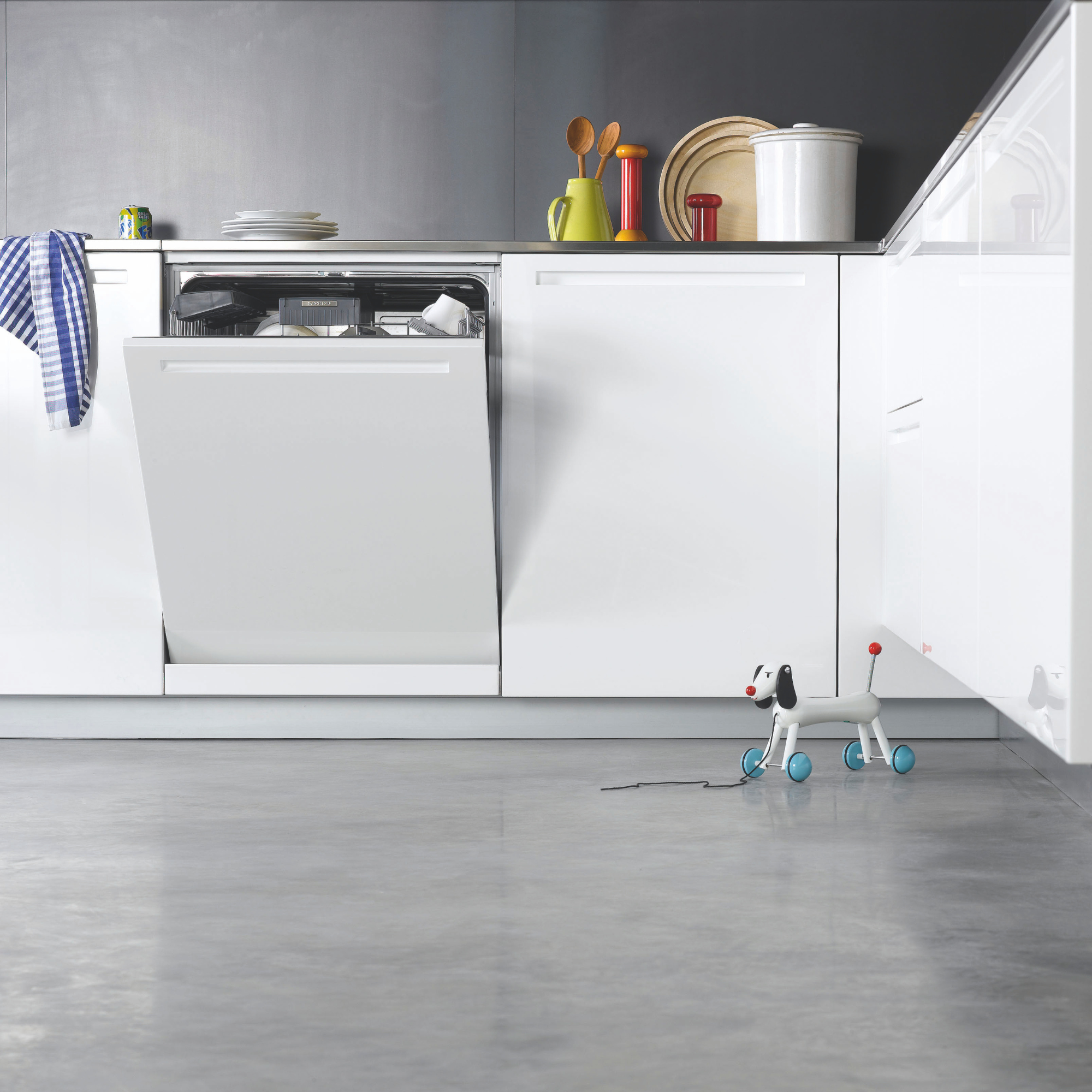
Keeping your dishwasher in tip-top condition is a must, especially if you depend on it daily. A key part of that is learning how to clean a dishwasher filter.
Figuring out how to clean a dishwasher properly is a good start but getting your machine squeaky clean requires a little bit more maintenance, specifically to the filter. This integral part of your appliance does a stellar job, catching food particles, grease, and other debris, helping to keep your dishes sparkling and your machine running smoothly.
Over time, this filter can get clogged, leading to less-than-perfect cleaning results and sometimes a whiff. Cleaning it regularly not only extends the life of your dishwasher but also ensures every plate, glass, and spoon comes out spotlessly clean.
Dimitry Letsman, Dishwasher expert at Hotpoint agrees: 'A clean dishwasher filter is essential to your dishwasher’s performance. It helps keep your dishes clean and ensures that the machine doesn’t break down.'
Plus, doing this one job can improve your machine’s efficiency, saving you time, water, and most importantly, the money it costs to run a dishwasher. If you’re not familiar with cleaning your dishwasher filter, don’t worry – it’s easier than it sounds.
We'll walk you through the step-by-step process, helping you tackle everything from locating the filter to giving it a thorough clean.
What you'll need
This cleaning brush set is ideal for cleaning a dishwasher filter, as you can use both these brushes to get into the nooks and crannies and release any lingering debris.
Dishwasher expert, Dimitry Letsman, from Hotpoint recommends getting your hands on one of the best best wet and dry vacuum cleaners to get the filter clear of debris, like this Karcher model we tested and deemed the best.
Grab a pair of rubber gloves when tackling cleaning a dishwasher filter, especially if you haven't done it before or are any way squeamish because there will be gunk to deal with.
Step-by-step
1. Empty your dishwasher and find the filter
First and foremost, it's best to start after your dishwasher has been through a cleaning cycle. Put your dishes away and set to work finding the filter, which isn't as tricky as it sounds.
'The filter is normally located underneath the lower rack in your dishwasher. To access it you’ll need to remove the lower rack. It’s important when you come to remove the filter that you make sure the safety is turned off. If you have two filters (which some dishwashers have) they will both be located under the lower rack and you can remove these by twisting the first one and the second one by simply lifting out. However, it’s best to check out the product manual to find specifically where the filter is located,' says Dimitry Letsman, Dishwasher expert at Hotpoint.

2. Remove the filter
Once you've located the filter, which is usually at the bottom of your dishwasher, gently pull out the bottom rack to access it properly and then twist it counterclockwise to release it.
You may need to apply a little pressure if it hasn't been cleaned in a while as it might be clogged.

3. Remove any debris
Next, remove any debris, wearing a pair of rubber gloves if you're at all squeamish (usually there's a build-up of fat and gunk to tackle.)
'Most filters consist of two parts: a cylindrical mesh filter and a coarse flat filter. Unscrew the cylindrical filter, rinse off food deposits and grime with warm water, and use a sponge or soft brush to remove stubborn residue,' explains Gwil Snook, AO's dishwasher expert.
Hotpoint's dishwasher expert, Dimitry Letsman, also advises clearing out the bottom of the dishwasher where the filter is located.
'Once you’ve removed your filter, the next step is to remove any debris that may have built up in the bottom of your dishwasher, as well as on top of the filter,' advises Dimitry.
'There are a few tools that can help achieve this goal, like a brush (the kind you use to scrub pots and pans) and even a small shop vacuum (you can find at most hardware stores.)'
4. Rinse the filter off
Rinse the filter thoroughly under warm running water, using a soft brush or old toothbrush (a kids' toothbrush is ideal) to remove any stuck-on food particles or grime. For tougher debris, a little dish soap can work wonders.
'If you can’t see any visible clogs, or if the dishwasher is still not cleaning well after replacing the filter, try rinsing it off with a garden hose. Run water over the whole surface of the filter and watch for any debris that comes loose. You may have to rinse it several times to clear all of this debris from your filter,' explains Dimitry.
'Now that your dishwasher filter should be clean and ready to go, you can install it back into your machine. Make sure there are no water bubbles trapped under its edges before doing so.'

5. Replace the filter and run a hot cycle
After giving the filter a good clean, dry it and click it back into place. Then give your clean dishwasher filter a whirl with a hot wash cycle.
'Once the dishwasher filter is cleaned, run a test load with nothing but water to see if any soap suds up in the bottom of your dishwasher. If you're not sure if your dishwasher's filter is clogged, check your owner's manual for instructions on how to do so - some models require disassembly while others can be cleaned by hand,' explains Dimitry Letsman, dishwasher expert for Hotpoint.
FAQs
How often should you clean a dishwasher filter?
Ideally, according to our experts, you should aim to clean it once a month to keep your dishwasher running at peak performance.
'Remember that a clean dishwasher filter is essential to your dishwasher’s performance. It helps keep your dishes clean and ensures that the machine doesn’t break down. And it is recommended that you properly clean your dishwasher filter every three months, to ensure top performance,' advises Dimitry Letsman, dishwasher expert at Hotpoint.
However, Lynsey Crombie a.k.a. Lynsey Queen of Clean recommends a little more often. She says, 'It is important this is rinsed and cleaned once a week to keep your dishwasher running efficiently and cleaning your dishes well.'
Although, it all boils down to how often you use your dishwasher, explains James Longley, Managing Director of Utility Bidder. 'Cleaning the filter is essential for your dishwasher’s performance. If you run daily cycles, you should aim to wash your filter monthly. For households using their dishwasher less frequently, once every three months should be enough.'
'That’s especially true if you don’t scrape or rinse items before loading the dishwasher,' says Heather Nixon, Sustainability, NPD and Regulatory Manager at Bio-D.
How do I know if my dishwasher filter is clogged?
There are a number of key give-aways that your dishwasher filter needs some extra attention so avoid one of the biggest dishwasher mistakes adding to your energy bills by taking the advice of the experts.
'If your dishes are coming out less clean than usual, you notice an unpleasant odour, or water is pooling at the bottom of the appliance, these can be signs of a clogged filter,' explains Gwil Snook, AO's dishwasher expert.
'Regular cleaning can prevent these issues. While most modern dishwashers have a removable filter, some models use a self-cleaning system.'
Dimitry Letsman, Hotpoint's dishwasher expert shares the signs your filter is clogged:
- Food left on dishes after the cycle has been completed
- Standing water, which is water that is left at the bottom of your dishwasher after a cycle has been completed
- Unpleasant smells
- If you are experiencing one or all three of these it’s probably a sign that your filter is clogged.
How do I know if my dishwasher has a removable filter?
Usually, most dishwashers have a removable filter but if you're not sure, it's worth locating your filter and seeing if it has a handle or cap, which is a sign it can be removed.
Dimitry Letsman, dishwasher expert at Hotpoint adds that 'the best place to find out if your dishwasher has a removable filter is in the user or appliance manual for your dishwasher.'







